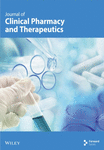Serum uric acid levels in cardiovascular diseases
Abstract
Objective: Comparison of the serum uric acid levels of healthy people ( n=71) and patients with cardiovascular diseases (CVD) (n=62). Subjects and methods: The patients included had either experienced acute myocardial infarction (AMI) ( n=31), atherosclerosis (AT) (n=23) or ischaemia ( n=8). The mean values (x±SD) of serum uric acid levels of the control group, the patients with CVD as a whole, and patients with AMI, AT and ischaemia were 4·15±0·45 mg%, 5·6±2·06 mg%, 5·96±2·60 mg%, 5·38±1·22 mg% and 4·94±1·40 mg%, respectively. A statistically higher level of serum uric acid was found in the controls compared to the CVD patients ( P < 0·05). Conclusion: The higher serum uric acid levels found in CVD patients suggests that any protective antioxidant effect which uric acid has is overwhelmed by other negative effects on pathogenesis.




